What is social media advertising? Social media advertising tips Hootsuite has been using social ads since 2012—a lifetime in the digital world. Use free social media to beta-test your paid social ads You’re likely already posting content on Twitter, Facebook, and Instagram every day—and maybe LinkedIn and SnapChat, too. Facebook advertising Ad types Facebook offers several different ad formats. For awareness campaigns, you promote your Tweets to a broad audience and pay for impressions (CPM). based on how targeted your ad is. Audience and targeting Instagram ads offer the same audience targeting option as Facebook ads, described earlier in this post. Here, you’ll use the targeting options to choose exactly who will see your Promoted Pin. Then, choose what type of ad to create. Ads options are available for Facebook, Instagram, Twitter, and Pinterest.

It’s no secret that digital advertising has become a key part of most marketing campaigns. Internet advertising spend overtook newspaper ad spending way back in 2013, and eMarketer predicts that it will overtake TV ad spending for the first time by the end of this year. The numbers are huge: an anticipated $72.09 billion spent on digital ads in the United States alone in 2016, a number expected to rise to more than $82 billion next year and more than $113 billion by 2020.
It probably comes as no surprise that Facebook is one of the biggest players in digital advertising, indicating that social media advertising is front and center in the digital ad world. In fact, Facebook blows all other digital properties out of the water when it comes to display ad spending, capturing 35.4 percent of total display advertising spending in the U.S.—a whopping $11.93 billion (second-place Google, by comparison, will take in just $4.79 billion).
And that’s just display ads. Facebook’s total social ads revenue was more than $6.8 billion in Q3 2016 alone. But the other social networks are nothing to sneeze at, with Twitter bringing in $545 million in social media advertising revenue in the same period. Snapchat will sell $367 million in social ads in 2016, after launching its ad platform just over a year ago. Total social ad spending in 2016 is expected to reach $32.97 billion. By 2018, Facebook alone will top that number.
Based on the social media advertising statistics, it’s clear your competitors are investing in social advertising platforms. In terms of ROI, more than 95 percent of social media managers say Facebook offers the best return, followed by Twitter and Instagram.
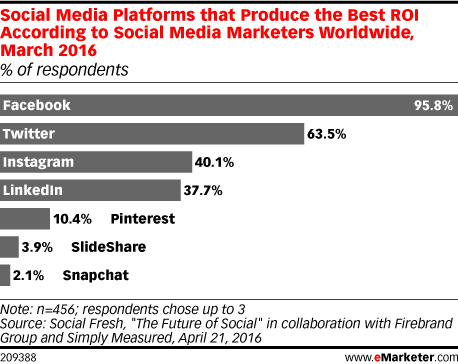
With so many choices, it can be a challenge to develop a social media advertising strategy that works for your unique business. In this beginner’s social media advertising guide, we dig into everything you need to know about launching a social ad campaign, then give you the nitty-gritty details on how (and why) to create ads on six of the most popular social networks.
What is social media advertising?
Before you start developing your social media advertising strategy, it’s important to understand exactly what social media ads are. Quite simply, a social media ad is any kind of paid content on a social media network. The options run from a one-off promoted Tweet or Facebook post to a full-scale campaign with major budgets attached. Each social network offers different options, and we’ll explore them in detail below.
Social media advertising tips
Hootsuite has been using social ads since 2012—a lifetime in the digital world. While the social ads tools and networks available are constantly evolving, the key principles of effective social media advertising are much more stable. After a couple of years of refining Hootsuite’s own social ad strategy, CEO Ryan Holmes laid out six ways to use social media ads to grow your business in an article that stands the test of time. Here are his tips.
1. Use free social media to beta-test your paid social ads
You’re likely already posting content on Twitter, Facebook, and Instagram every day—and maybe LinkedIn and SnapChat, too. Some of these posts will resonate with followers; others won’t. Track which ones are being clicked, liked, shared, and commented on. These high-performing messages make the best candidates for social ads.
2. Take advantage of targeting features
Traditional ads are inefficient. One of many social media advertising benefits is that social platforms offer very effective targeting capabilities to address that problem. From targeting social media managers on LinkedIn to Stranger Things fans on Facebook, take advantage of this very useful targeting for more efficiency in advertising.
3. Rotate ads frequently
Though it’s annoying to see the same TV ad in every commercial break, repetition is an effective way of hammering home the message using one-way communication. But on advertising channels where engagement is key, and ads appear directly in users’ feeds, fresh content is the name of the game. Overly repetitive messaging may end up losing you more business than you gain. Hootsuite has found the best practice is to rotate ads every three to five days.
4. Use small samples to test the text and images used in your ads
One of the great virtues of social ads is instant feedback. You can gauge the effectiveness of a sponsored post in minutes and follow up with advanced analytics reports. The best practice is to test several ads with small audiences to determine what works best, then use the winning ad in the primary campaign.
5. Understand how ads are sold on different networks
You’ll learn the details below, but keep in mind that keeping your social media advertising budget under control means thinking about whether you’re designing an ad campaign based on impressions or engagements. If you’re paying every time someone sees your ad (impressions), your message can cast a wide net. But if you’re paying for engagement, you only want people who are really interested in doing business with you to engage. The wording of your ad should help people self-qualify.
6. Design ads with mobile in mind
More than 80 percent of social network users are accessing social media on a mobile device in 2016. This means most social media ads are being viewed on mobile devices as well. Your mobile ads should be specifically designed for the small screen, incorporating images that are easy to view on a pocket-sized device. You can also take advantage of “geofencing” to target mobile users when they are in a specific zip code, so they only see your ads when they are close enough to walk in your front door.
Now that you understand some basic social media advertising guidelines, let’s dive into the specifics of advertising with each of the main social networks.
Facebook advertising
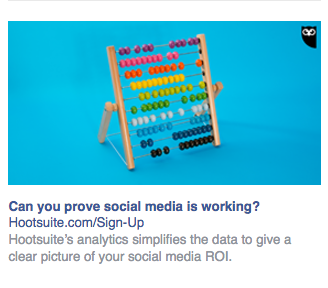
Ad types
Facebook offers several different ad formats.
Photo ads
The technical specifications for photo ads vary depending on the ad objectives, so you should check the details on Facebook Business. For clicks to your website, for example, photo ads offer a headline of 25 characters, 90 characters of test, and a link description of up to 30 characters. Depending on the ad objective, you may also be able to add a call to action button with actions like Shop Now, Learn More, and See Menu.
Video ads
Video ads generally have the same call to action options and character counts as photo ads. The aspect ratio required depends on the campaign objective, but 16:9 or 1:1 will usually work.
Carousel
A carousel ad lets you include up to 10 images and links in one ad. You get 90 characters of text, a 40 character headline, and a 20 character link description. Images should be have a 1:1 image ratio.
Slideshow
A slideshow is an ad that creates a video from several static images. All images should have the same size and aspect ratio.
Canvas
Canvas is a full-screen mobile ad type that combines videos, photos, and call to action buttons. It allows users to tilt and zoom to interact with the imagery.
Audience and targeting
Facebook offers extensive targeting options, and choosing the best target audience will maximize the value of your ad spend.
Start by targeting your ad based on location, age, gender, and language. Then, you can dive into Facebook’s detailed targeting options:
- Demographics allows you to filter for nine demographic categories: education, ethnic affinity, generation, household composition, life events, parenting, politics (U.S. only), relationship, and work.
- Interests breaks the many interests Facebook users indicate through their social media activity down into nine broad categories: business and industry, entertainment, family and relationships, fitness and wellness, food and drink, hobbies and activities, shopping and fashion, sports and outdoors, and technology. Each of these has multiple subcategories, so you can drill down quite deep in your targeting.
- Behaviors allow you to filter users based on their behaviors on Facebook and information Facebook gathers from partners.
You can also choose to target or exclude people who already have a connection with you on Facebook, as well as those people’s friends.
Facebook also lets you create a custom audience by uploading a list of email addresses, phone numbers, Facebook user IDs, or app user IDs. You can then use lookalike audiences to find other people on Facebook that are similar to that audience.
Once you’ve created your target audience, you can narrow your focus even further based on type of device, and even whether the Facebook user is connected via data or Wi-Fi.
Pricing
Facebook ad pricing varies based on quite a few factors, including the time of year, the country you’re targeting, and even the quality of your ad. On average the cost per click in the United States in Q3 2016 was 27.35 cents, and the CPM was $5.95. But the average CPC in Australia was nearly 80 cents—a huge difference.

The cost per click varies by placement, with ads in the desktop news feed costing $0.29 per click compared to $0.18 for mobile in Q3 2016.
How to buy
Before you buy your first Facebook ad, you’ll need to set up a Facebook business page. Once your page is ready to go, you can head over to the Facebook Ads manager to create your first ad.
Step 1: Choose your campaign objective
Facebook offers 15 different campaign objectives, broken down into the three broad categories of awareness (boost posts, increase brand awareness), consideration (app installs, lead collection), and conversion (website conversions, visits to your offline store).
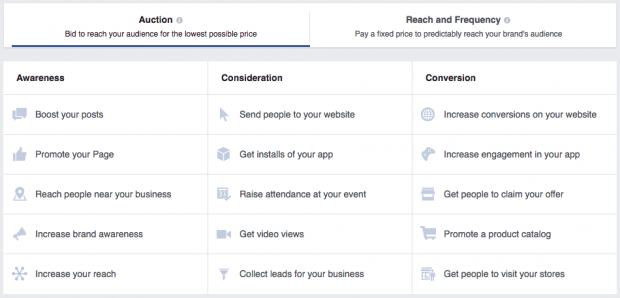
Choose the objective that best aligns with your goals for this particular Facebook ad. For some help narrowing down the best goal for your ad, check out our guide to Facebook advertising strategies.
Step 2: Choose your target audience and placement
Keep an eye on the meter on the right side of the page that indicates the breadth of your audience selection, along with the estimated daily reach chart on the bottom right. Notice that Instagram is among the placement options. (We’ll delve further into advertising on Instagram below.)
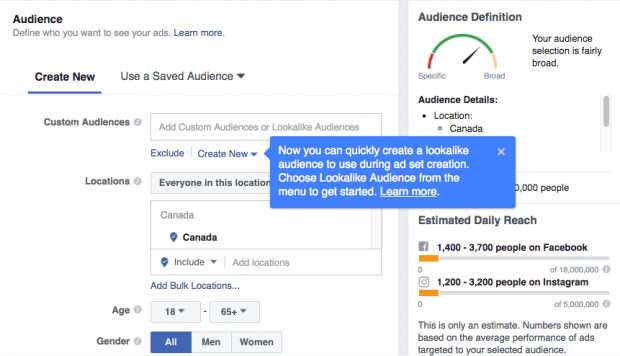
Step 3: Set your budget and schedule
You can choose a daily or lifetime budget, then set start and end dates for your ad or set it to start running right away.
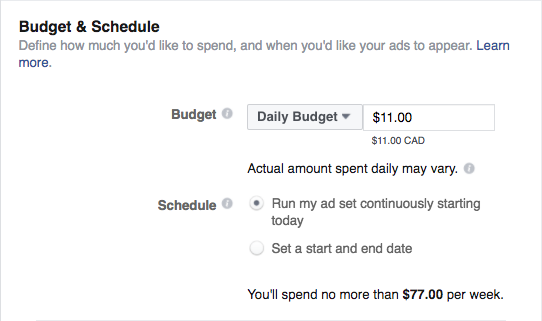
The advanced budget options allow you to really control what you spend by choosing whether to optimize your ad delivery for engagement, impressions, or unique daily reach, and whether you pay by impression or engagement (for engagement ads only).
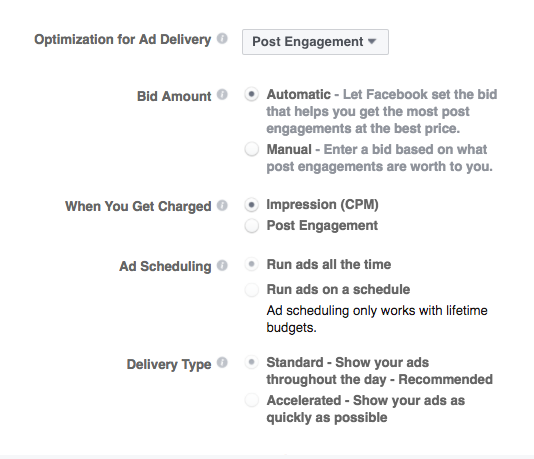
Step 4: Create your ad
You can choose to create a new ad or use an existing post. If creating a new ad, you first…
COMMENTS